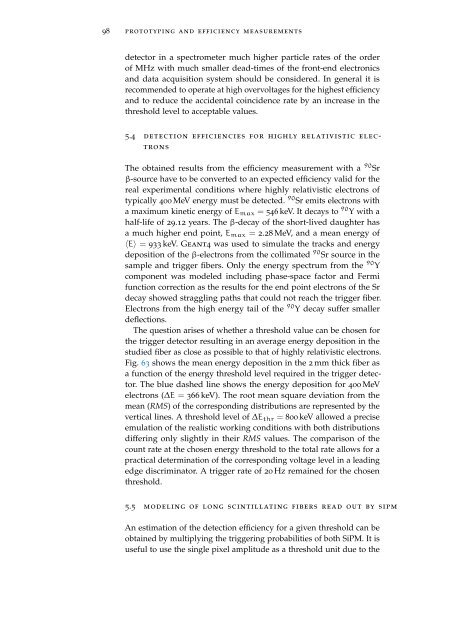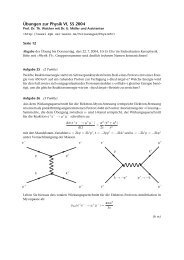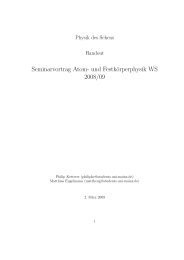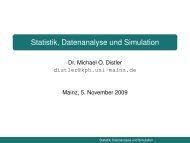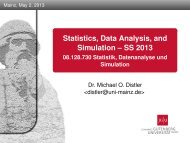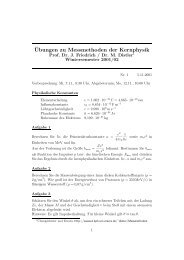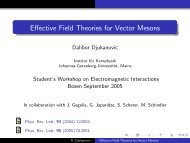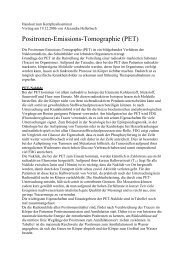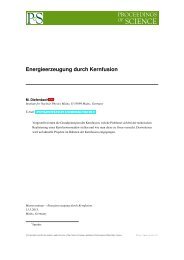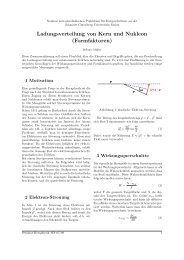A Classic Thesis Style - Johannes Gutenberg-Universität Mainz
A Classic Thesis Style - Johannes Gutenberg-Universität Mainz
A Classic Thesis Style - Johannes Gutenberg-Universität Mainz
Create successful ePaper yourself
Turn your PDF publications into a flip-book with our unique Google optimized e-Paper software.
98 prototyping and efficiency measurements<br />
detector in a spectrometer much higher particle rates of the order<br />
of MHz with much smaller dead-times of the front-end electronics<br />
and data acquisition system should be considered. In general it is<br />
recommended to operate at high overvoltages for the highest efficiency<br />
and to reduce the accidental coincidence rate by an increase in the<br />
threshold level to acceptable values.<br />
5.4 detection efficiencies for highly relativistic electrons<br />
The obtained results from the efficiency measurement with a 90 Sr<br />
β-source have to be converted to an expected efficiency valid for the<br />
real experimental conditions where highly relativistic electrons of<br />
typically 400 MeV energy must be detected. 90 Sr emits electrons with<br />
a maximum kinetic energy of Emax = 546 keV. It decays to 90 Y with a<br />
half-life of 29.12 years. The β-decay of the short-lived daughter has<br />
a much higher end point, Emax = 2.28 MeV, and a mean energy of<br />
〈E〉 = 933 keV. Geant4 was used to simulate the tracks and energy<br />
deposition of the β-electrons from the collimated 90 Sr source in the<br />
sample and trigger fibers. Only the energy spectrum from the 90 Y<br />
component was modeled including phase-space factor and Fermi<br />
function correction as the results for the end point electrons of the Sr<br />
decay showed straggling paths that could not reach the trigger fiber.<br />
Electrons from the high energy tail of the 90 Y decay suffer smaller<br />
deflections.<br />
The question arises of whether a threshold value can be chosen for<br />
the trigger detector resulting in an average energy deposition in the<br />
studied fiber as close as possible to that of highly relativistic electrons.<br />
Fig. 63 shows the mean energy deposition in the 2 mm thick fiber as<br />
a function of the energy threshold level required in the trigger detector.<br />
The blue dashed line shows the energy deposition for 400 MeV<br />
electrons (∆E = 366 keV). The root mean square deviation from the<br />
mean (RMS) of the corresponding distributions are represented by the<br />
vertical lines. A threshold level of ∆Ethr = 800 keV allowed a precise<br />
emulation of the realistic working conditions with both distributions<br />
differing only slightly in their RMS values. The comparison of the<br />
count rate at the chosen energy threshold to the total rate allows for a<br />
practical determination of the corresponding voltage level in a leading<br />
edge discriminator. A trigger rate of 20 Hz remained for the chosen<br />
threshold.<br />
5.5 modeling of long scintillating fibers read out by sipm<br />
An estimation of the detection efficiency for a given threshold can be<br />
obtained by multiplying the triggering probabilities of both SiPM. It is<br />
useful to use the single pixel amplitude as a threshold unit due to the


